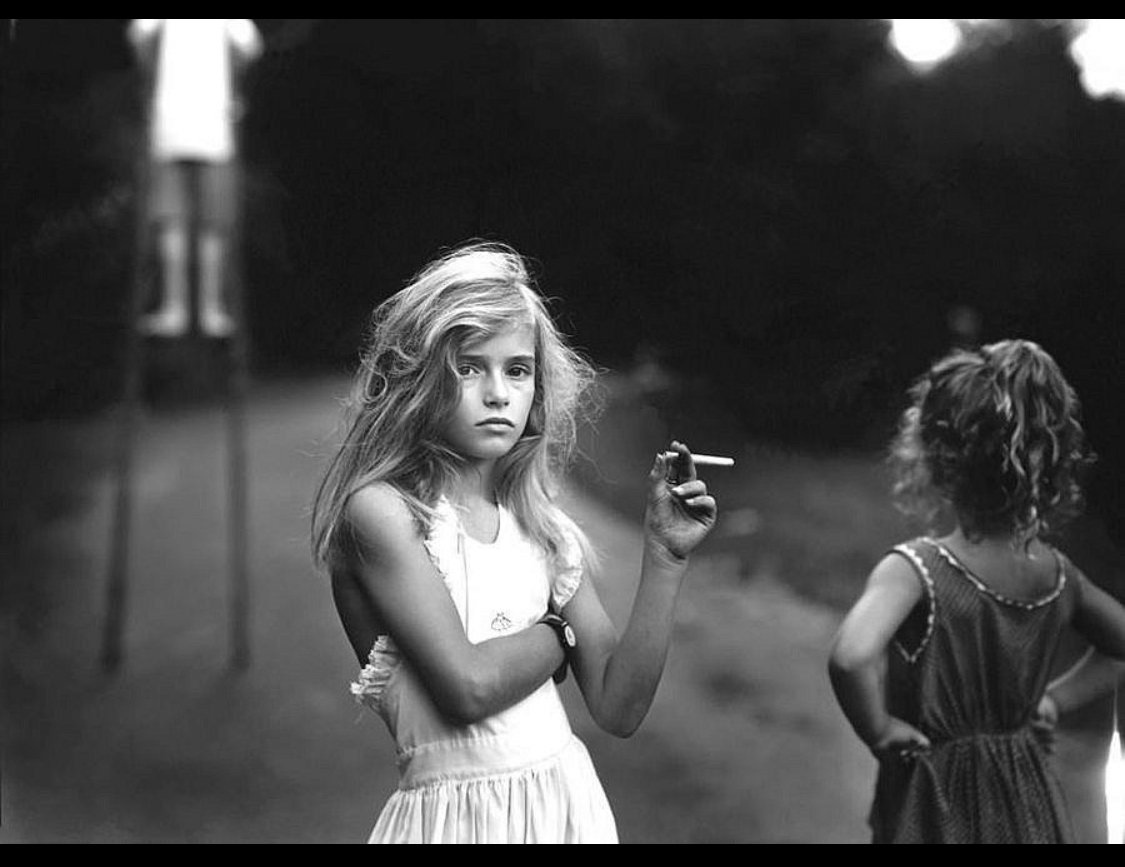Candy Cigarette (1989)
My eyes immediately fix upon the focal point of the photograph: a young girl in a white dress holds a candy cigarette and stares back at me. I shall soon enough return to her, the subject of the photograph.
Note: Though not visually obvious to me, l presume a literal interpretation of the title is correct and the cigarette is, in fact, candy. Were it real, "Candy Cigarette" would be imbued with a level of on-the-nose, baked-in irony far beneath the quality of the work.
The matching white of her dress and a t-shirt brings my gaze first toward the background to find a child facing away from me, high atop stilts. This is a decidedly daring activity brimming with the potential energy of height (and childhood) void of any fear of injury via falling to the ground (adulthood), neither now nor in the (faraway concept of) "future." I next remember my own zero-fear, daredevil exploits at this age on a BMX bike.
Now screaming down a steep hill in Newport, Rhode Island, my front tire strikes a makeshift ramp, launching this tiny version of me impossibly high into a light-blue sky. My bike and I land confidently with a thud. Over the cheers of some friends I yell, "Make it one more [milk] crate higher!"
The out-of-focus quality of the white shirt against a black void of forest, cropped just below the shoulders by the top of the frame are all guiding, artistic choices. The shirt reveals itself to me in its singular, levitating, ethereal form. It is an angel with wings, as if hurriedly drawn by a child at this very age, just before recess. Facing away from me in purity and bliss, I do not exist. It is not conscious of fear, or accidents, or an awaiting-adulthood. I both envy the angel and am thrilled for it. "Enjoy!" I hear myself say. "Don't turn around!"
My focus now sweeps to the right, to the back of a girl observing the child on stilts. Upon comparing her to the subject, I can see the strategic use of a very shallow depth-of-field; although just a few steps forward of, her hair appears less sharp than the subject's. Her hands could be taken as resting sternly on her hips, though I get the sense she is merely watching the angel-child from both a real and metaphorical distance. Having not yet turned around to see me or fully process the concepts inherent with adulthood, she is still close enough to feel them. She wants to take a turn on the stilts, yet cannot from fear of thoughts and a potential fall.
Perhaps her hands have raised to her hips emulating her mother's judgment, without yet knowing why. I want to tell her, "Don't look back! Run to the stilts!" Yet with silent, profound sadness I concede the point. She is mere inches from turning to enter the sharp reality of her elder. It is already too late.
I fixate again on the girl facing me, then the candy cigarette to ponder its absurd existence. For the innocence and the simplicity and the wonderment and the delight of childhood is fleeting. Who knows that more vividly than us, who can never return to reclaim it? Why would any adult candy-coat (i.e. create, sell or purchase) such a stage prop for a child? By definition it can only serve as a catalyst, however slightly, to the emulation of and transition to adult behavior. Why light the path when there is only one? Why speed the journey when it is over too soon?
While at first glance one might think this is a brilliant example of candid portraiture, I believe Sally Mann here was exacting, in the very same manner of Gregory Crewdson. I see a girl, still too young, turned to face me and my kind, having put away childish things. Her tousled hair, her dress, her watch in recognition of time and appointments, her arm defensively crossed under the other, the cigarette held as if she'd smoked a thousand before, her stance and frown for having been out there all day, and the striking indifference in her eyes in spite of seeing it all ... they all conjure the defiance of a street-smart prostitute on a smoke break. Whether consciously or unconsciously directing her child's physicality to exactly that, I believe Sally Mann heightened, then focused on the blurry juxtaposition of a child pulled too soon into the adulthood it has been surrounded by from birth.
I can imagine the photographer's final, exacting direction of tiny adjustment to the angle of the candy cigarette, then the shudder, then the exhale in relief of having captured a moment exactly as it was so exquisitely designed.
